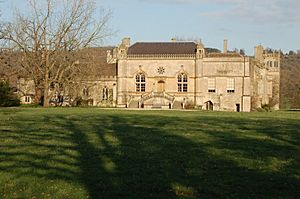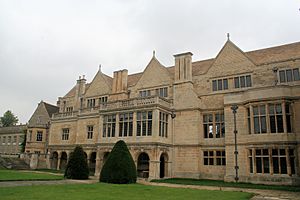Grace Mildmay facts for kids
Grace, Lady Mildmay (born Grace Sharington, around 1552–1620) was an important English noblewoman. She kept a detailed diary and was also a skilled medical practitioner. Her autobiography is one of the very first written by an English woman that we still have today. Grace was born in Wiltshire. In 1567, she married Sir Anthony Mildmay and moved to Apethorpe Palace in Northamptonshire, which was his father's home. She used her wide knowledge of medical theories and many cures to help her family and others. Her writings included her life story, medical notes, and spiritual thoughts.
Contents
Early Life and Education
Grace Sharington was born around 1552 in Wiltshire. She was the second daughter of Sir Henry Sharington and his wife, Ann. Her family lived at Lacock Abbey. Grace had an older sister, Ursula, and a younger sister, Olive. Their brother, William, died when he was a baby.
Her governess, Mistress Hamblyn, taught Grace strong religious values. She also taught her some medical knowledge, including basic surgery. Grace also learned music, needlework, arithmetic, and how to write letters. In her writings, Grace remembered seeing visitors at Lacock Abbey who behaved badly. Mistress Hamblyn encouraged her to write poems against such behavior. From her mother, Grace learned to spend time each day thinking about spiritual things. Later in life, she wrote many pages of these spiritual thoughts.
Marriage and Life at Apethorpe
In 1567, Grace married Sir Anthony Mildmay. He later became an ambassador for England in France. Anthony was the oldest son of Walter Mildmay, who was a very important government official called the Chancellor of the Exchequer. Sir Walter helped make sure Grace and Anthony married, even though Anthony was not very keen at first.
For almost twenty years, the Mildmays lived at Apethorpe Palace in Northamptonshire with Sir Walter. Sir Anthony was often away, either at court or in France. Lady Mildmay stayed at Apethorpe. She spent her time with religious activities, music, and practicing medicine. She also looked after the daily religious services at Apethorpe Palace. Lady Mildmay helped people in the local area through her charitable work.
A Skilled Healer
Lady Mildmay's medical practice went beyond just her family. She had a deep understanding of illnesses and how to cure them. Her knowledge was based on old medical ideas, and also inspired by her Christian faith. She made many different cures. These came from plants, but also from chemicals and minerals. She often made common remedies in very large amounts, sometimes ten gallons at a time. One special balm she made had 159 different ingredients. These included seeds, roots, spices, and gums. It also had 13 pounds of sugar and nuts, and over 8 gallons of oil, wine, and vinegar.
Her daughter, Mary, later received her medical books. She also inherited more than two thousand loose medical papers and many different cures.
Later Life and Legacy
The Mildmays faced money problems during their marriage. This was partly because of debts Sir Anthony got from his political and military work. Sir Henry Sharington, Grace's father, died in 1581. His two surviving daughters, Grace and Olive, argued over their inheritance for many years. Grace eventually won an equal share of her father's wealth.
Sir Anthony died in 1617. Lady Mildmay passed away on July 27, 1620. She was buried next to her husband at Apethorpe church. Their only child, Mary Mildmay, married Francis Fane, 1st Earl of Westmorland. They had 14 children, including Mildmay and Francis.
Lady Mildmay's autobiography is one of the earliest written by an English woman that still exists. It was first published in parts in 1911. Her monument at St Leonards describes her as a very religious and pure woman. It says she was kind and helpful to anyone in need. She helped with medicine, clothes, food, or advice. Her life was a blessing to her, and her death blessed those around her.



